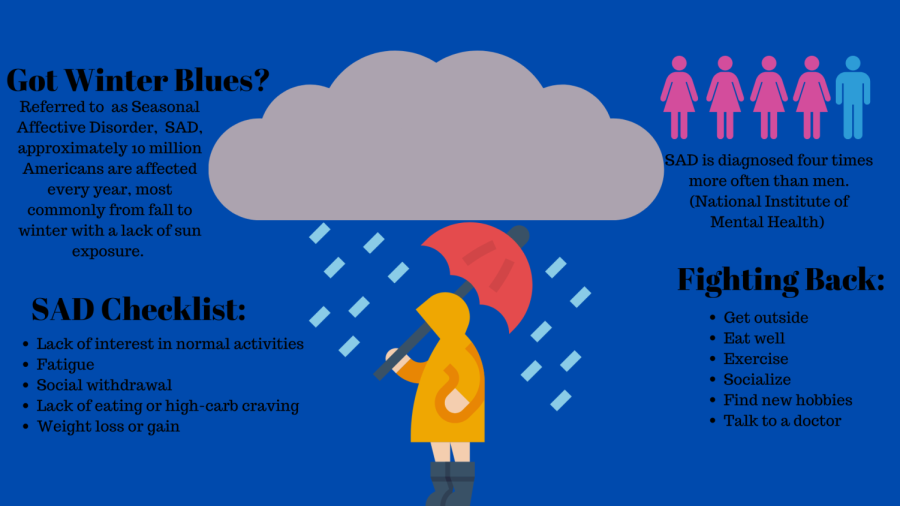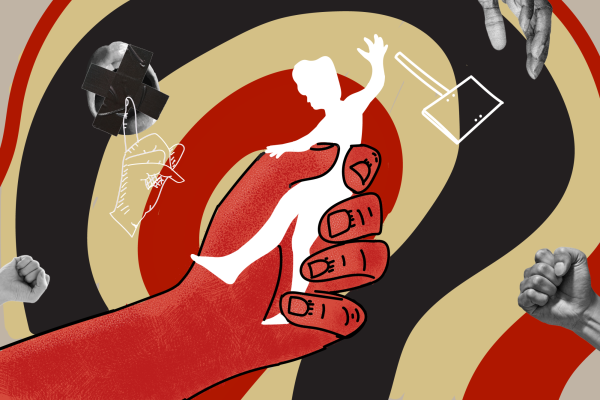Seasonal Affective Disorder: How is it different from other forms of depression?
“Signs of Seasonal Affective Disorder and ways to fight back.”
With the months changing and the sunny days soon to become more gloomy, one thing essential to understand is Seasonal Affective Disorder, also known as seasonal depression.
SAD is a form of depression triggered by a change in seasons, typically when fall and winter start. The seasonal depression only worsens as the sunnier days become limited. Like most forms of depression, SAD can affect your everyday life in several ways.
Some of the more well-known forms of depression include Major Depressive Disorder, Persistent Depressive Disorder and Psychotic Depression. While all forms of depression have similar symptoms and treatments, there are significant differences when navigating what you may feel.
Major Depressive Disorder involves a sad mood that persists for more than two weeks. Usually, there is a decline in energy, loss of appetite, feelings of emptiness, numbness and a loss of interest.
Persistent Depressive Disorder is a type of chronic depression that lasts more than two years. It commonly involves milder feelings of sadness and hopelessness. Although less severe than other forms of depression, the sense of distress generally intensifies.
Psychotic Depression describes a form of depression that involves psychosis, hallucinations, delusions or paranoia. As this type of depression is not as expected, their limited knowledge is understood about this form.
According to The National Institute of Mental Health, “Depression is estimated to affect 280 million people worldwide.”
Considering depression is one of the most common illnesses in our world, most people do not understand that there are several different forms. Therefore, seasonal depression is often mistaken for another form of clinical depression.
According to the Cleveland Clinic, “About 5% of adults in the U.S experience SAD. It tends to start in young adulthood, usually between the ages of 18 and 30.”
Symptoms of seasonal depression include sadness, anxiety, weight loss or gain, fatigue, hopelessness, easily agitated, oversleeping or insomnia, loss of interest in favorite activities, distancing from loved ones and thoughts of harm or suicide. Since symptoms that relate to seasonal depression and other forms correlate, it raises the question of how to differentiate which type of depression you may be feeling.
“A person suffering from major depressive disorder would experience common symptoms such as depressed mood, weight gain, excessive sleep or drowsiness, a loss of interest in things previously enjoyed,” said Dr. Scanlon. “The mentality that someone can endure a [seasonal] depressive episode means that they will likely have a period of several weeks of struggling with emotions.”
While researchers speculate that the decrease in sunlight exposure is a leading cause of depression, it is believed to be caused by the change in your body. For instance, the lack of sunlight can overproduce melatonin, causing fatigue, Vitamin D deficiency that lowers your serotonin level, biological clock and an imbalance in your brain when neurotransmitters that communicate between your nerves are adjusted.
Seasonal depression can be treated in several ways. Some include light therapy, cognitive behavioral therapy, Vitamin D, medication and spending time outdoors. Light therapy uses a white fluorescent lamp that you periodically spend time around to mimetic the sun. Cognitive behavioral therapy is a psycho-social intervention that reduces symptoms of various mental health conditions. A Vitamin D supplement will compensate for the lack of sun exposure. Medication can temporarily be used to balance brain chemicals. Spending time outdoors will give sun exposure even if the sun is suppressed and will allow the body to enjoy time with nature.
Like any form of depression, SAD is a valid feeling. As the chilly and gloomy weather begins to creep in, continue going outside and maintaining a healthy lifestyle. If you or someone you know is suffering, do not hesitate to contact a doctor or someone you trust or contact the Substance Abuse and Mental Health Services Administration 24-hour hotline at 1-800-662-HELP (4357).

Hi everyone! My name is Kaelin Collar, and I'm a sophomore majoring in biology on a pre-medical track from Oregon. I've been with The Prairie News for...



















